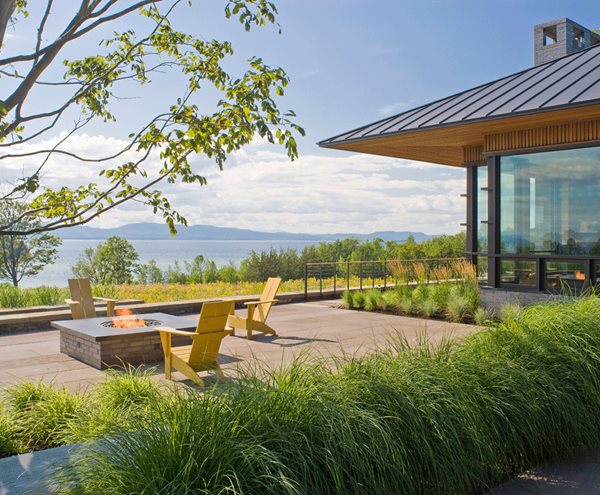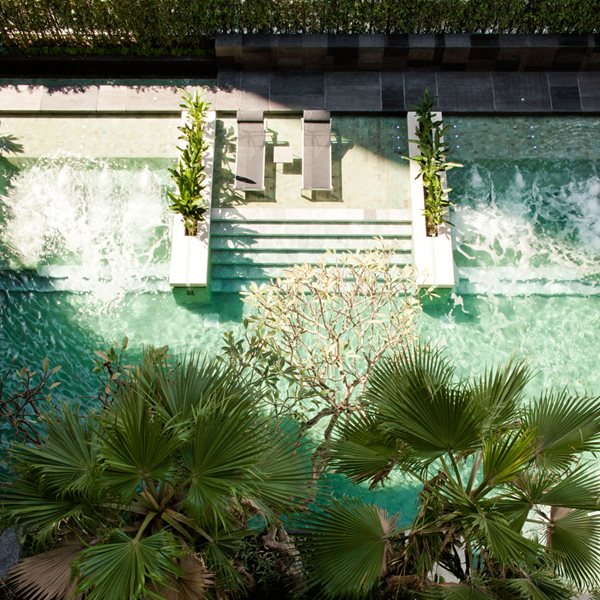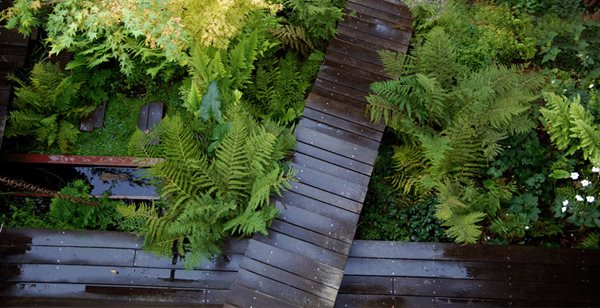ASLA's 2012 Best Residential Landscapes
Each year the American Society of Landscape Architects (ASLA) awards professional awards to the year's best residential landscape designs. We have the winners from this year's competition, from a brilliantly reimagined former rock quarry (above) in Connecticut to a home in Mexico with spectacular outdoor rooms.

This year, all the winners in the residential category of the American Society of Landscape Architects awards, the most prestigious in the field, prioritized sustainability, which is now almost a given. But there's also something powerful going on at an aesthetic level. Call it celebrating a sense of place or making the most sensible use of climate or geography.
To read our full article about the winners, pick up a copy of our Winter 2012 issue. And for more information about the winners, visit ASLA's website.
All caption information from ASLA and the project winners.
Left: ASLA Award Winner Malinalco Private Residence by Mario Schjetnan, FASLA / Grupo De Diseño Urbano, S. C., Mexico City
The guesthouse at Malinalco abuts the water lilly–filled reservoir.

ASLA Award Winner Malinalco Private Residence by Mario Schjetnan, FASLA / Grupo De Diseño Urbano, S. C., Mexico City
The open areas surrounding this Malinalco private residence are a sequence of transitional gardens, terraces, and outdoor rooms. The different ambiences, combined with the endemic vegetation and presence of running water along the paths, provoke reflection and contemplation of the landscape.
Left: Water basin, garden, tennis court and garden.

ASLA Award Winner Malinalco Private Residence by Mario Schjetnan, FASLA / Grupo De Diseño Urbano, S. C., Mexico City
Malinalco Residence is located in the southern portion of the Malinalco Valley, in a setting of old coffee and fruit orchards, where a system of ancient “apantles” or open-air irrigation channels persists. The Aztecs chose this high valley area to erect a citadel; its strategic position made the Spanish conquest of the area particularly difficult.
Left: An “apantle” channel, which runs briskly aside the pedestrian walkways, empties into a rock basin surrounded by Philodendron sagittifolium, Sedum praealtum and banana trees.

ASLA Award Winner Maple Hill Residence in Westwood, MA, by Stephen Stimson Associates Landscape Architects, Cambridge, MA
The Maple Hill Residence is a five-acre residential landscape comprised of a new house, barn, pool and outbuildings. The design sets the residence to one side of the property leaving the majority of the site open for the development of the landscape program. Close collaboration between the Architect, Landscape Architect and Client created a home that blends the programmatic needs of the family with an interactive and resourceful mind-set about the landscape they inhabit.
Left: The stone walls define a path which crosses over the water garden. The barn frames the space and provides a potting area for the adjacent vegetable garden.

ASLA Award Winner Maple Hill Residence in Westwood, MA, by Stephen Stimson Associates Landscape Architects, Cambridge, MA
The building program included a new residence, barn, pool house, potting shed and swimming pool. The Owners wanted to create a new home and clearing in a woodland setting that would be fully integrated into the site on a number of levels. With a family of three young children they envisioned a landscape that would incorporate their strong environmental ethic and encourage exploration, engagement and awareness of the natural environment. In response, the design created a wide variety of landscape spaces and habitats. These supported the production of food for the family, opportunities for active recreation, social gatherings and large family events, and the enhancement of the native ecosystem.
Left: The wood pergola uses the same material palette of the barn to maintain a consistent language.

ASLA Award Winner Maple Hill Residence in Westwood, MA, by Stephen Stimson Associates Landscape Architects, Cambridge, MA
The productive landscape is composed of an orchard of dwarf apple trees, a 50’x 50’ vegetable garden and potting shed, and herb garden at the kitchen. The entire family enjoys the active planting and harvesting cycle in all of these areas. This project seeks to enhance the landscape diversity of the project site while integrating architecture and landscape in a visible fashion. Organic maintenance practices and on-site harvesting encourage stewardship of the land and instill an environmental ethic that respects local plant and animal communities.
Left: The family’s vegetable garden is a generous 50’ by 50’ plot with raised stone planters and peastone paths, enclosed by an 8’ mesh, steel and wooden deer fence.

ASLA Award Winner New Century Garden: A Garden of Water and Light in Palm Springs, CA, by Steve Martino and Associates, Phoenix, AZ
Palm Springs is a city known for its love and appreciation of its “Mid-century” modern architecture and history. The project strives to be the “New-Century Garden” by utilizing contemporary materials, technologies and attitudes to create a bold new and unique desert experience that reflects the design and social history of Palm Springs while showing a desire to celebrate its rugged desert region as a model for design in this new century.
Left: The entry garden, with its ‘canyon plantings’ greets visitors.

ASLA Award Winner New Century Garden: A Garden of Water and Light in Palm Springs, CA, by Steve Martino and Associates, Phoenix, AZ
The client, a designer himself, wanted a stunningly gorgeous environment with a variety of places to entertain at all scales from intimate parties to large fundraising size events. His instruction to the landscape architect was to create an outdoor environment that was “groovy, cool and sexy.” This high style garden strives to accomplish these goals while transcending the region’s social landscape, represented in its lawns, palm trees and golf courses.
Left: View to the guest casita’s terrace and water feature with cactuses. The room and terrace have views to the mountains, the water helps mask the street sounds beyond the hedge.

ASLA Award Winner New Century Garden: A Garden of Water and Light in Palm Springs, CA, by Steve Martino and Associates, Phoenix, AZ
This new house and garden is built on 1–1/2 acres in the chic Old Las Palmas neighborhood in Palm Springs. The project was the second collaboration for the owner and the landscape architect who had developed a productive working relationship on a previous remodel of a mid-century-modern house. The client expected the highest level of design and also expected the project to raise the bar for outdoor living and desert style.
Left: The ochre ‘Domino’ wall flanks the garden at the two guest rooms of the main house.

ASLA Award Winner Quaker Smith Point Residence Shelburne, VT, by Keith Wagner Partnership, Burlington, VT
The house site included many mature shade trees and a 10’ grade change gently sloping to the lake. The clients wished to create a compound including a main house, convert an existing barn into a guest house, an arrival court, entertainment terraces, an outdoor hearth, a small vegetable garden and a water feature.
Left: At night LED lighting underneath the lilac bluestone bridge makes it appear to float, lending an ethereal feel to the entrance.

ASLA Award Winner Quaker Smith Point Residence in Shelburne, VT, by Keith Wagner Partnership, Burlington, VT
The grand 19th century structures of Shelburne Farms were built with locally available materials, slate, stone and locally harvested wood, out of necessity. The tradition of using local materials was continued while introducing Corten steel. This material eludes to the farm equipment relics that are peppered throughout the site, a homage in material to the agricultural past, present and future of the Farms.
Left: The water cascades over two Corten walls into a final basin with a large ledge stone slab bridge. These final two falls are adjacent to the master suite and add a calming effect.

ASLA Award Winner Quaker Smith Point Residence in Shelburne, VT, by Keith Wagner Partnership, Burlington, VT
The existing house built over 40 years ago, was not energy efficient, awkwardly sited and turned its back on the dramatic views to Lake Champlain and the Adirondack Mountains. The clients, an art collector and an entrepreneur, were attracted to this parcel for the outstanding 10 acre house site and the option to lease an additional 5 acres of adjacent land for their hobby, raising English Shire draft horses.
Left: Close attention was paid to setting up horizons and views from the house and terraces. The stone plinth wall allows the house and terraces float above the meadow and distant views of Lake Champlain.

ASLA Award Winner Reordering Old Quarry in Guilford, CT, by Reed Hilderbrand LLC, Watertown, MA
In this 1950s subdivision, most homeowners have buried the site’s history as a working quarry under a layer of suburban lawn. By contrast, this project celebrates the found coastal conditions, refining, editing, and rearranging the remnant tailings and embracing the rough character of the emergent woodland. Targeted and modest interventions enhance the dynamic quality of the groundplane and accentuate the effect of subtle variations in elevation on this coastal site.
Left: Restored house and pavilion from the jetty.

ASLA Award Winner Reordering Old Quarry in Guilford, CT, by Reed Hilderbrand LLC, Watertown, MA
By 2006 when a new owner bought the house, decades of benign neglect had made the site physically and visually impenetrable under dense thickets of poison ivy and invasive exotics. The new owner, an architect, sought to restore the deteriorating house and directed the landscape architect to shape a livable, modern, low-input landscape to complement the restored building and small addition. The landscape architect’s response was not a manicured suburban landscape, but one that celebrated the found conditions of the quarry, the coastal aspect, and the emergent nature of the vegetation.
Left: Stepping stones and a grove of carpinus between the original house (at left) and the addition.

ASLA Award Winner Reordering Old Quarry in Guilford, CT, by Reed Hilderbrand LLC, Watertown, MA
This project primarily utilizes refuse stone found on site. To provide access through the rubble, the granite has been turned and worked just enough to create level, steady paths. The remnant borrow pit was cleared of invasives and some of its edges clarified to accentuate its depth. At the bottom of the pit, ledge is revealed and there are pockets of soil that support native grasses.
Left: The ordered arrangement of the granite breaks down as it cascades into the existing borrow pit.

ASLA Award Winner Quattro by Sansiri Bangkok, Thailand, by TROP Company Limited, Ladprao, Thailand
Three gardens designed for a new condominium in the middle of over-crowded Bangkok. The main idea is to respect the existing "residents." which are old giant Rain trees (Leguminosae Mimosoideae) and their small inhabitants (squirrels and birds) and to encourage the new residents to live with Nature. The Rain Trees become the heart of our design, while all other garden elements are created to complement those trees.
Left: Looking from above, the main garden appears as it has been here with the old trees since the beginning.

ASLA Award Winner Quattro by Sansiri Bangkok, Thailand, by TROP Company Limited, Ladprao, Thailand
Design-wise, the inspiration comes from the project's name, Quattro (4), playing with a combination of rectangular shapes, combining them into thee-dimensional garden compositions. Some bigger rectangles become terraces, while the smaller ones are used as stepping pathways. A series of rectangular stones is also used on the pavilions' walls, creating semi-enclosed space for their users.
Left: To maximize the use of space, hardscape terraces are kept to a minimum. Instead, we proposed shallow pool for sun lounge chairs, with Jacuzzis at the sides.

ASLA Award Winner Urban Spring in San Francisco, CA, by Bionic, San Francisco, CA
San Francisco's springs and streams were once common and visible, emerging from hills and ultimately draining to the Bay. Today most are routed through pipes and city sewers. In contrast, the spring surfacing at this residence informed steps and strategies of a larger building renovation and garden design. The design applies precise structures, devices and details to the nuanced conditions of the site, creating an elegant composition of functional spaces, microclimates, and urban wildlife habitat.
Left: The copper rain chain drips into the spring basin amidst the canopy of Japanese maple and woodland plant species. A bench traverses the space from east to west while mini decks provide basin access and alternative navigation through the garden.

ASLA Award Winner Urban Spring in San Francisco, CA, by Bionic, San Francisco, CA
This combination of natural and manmade conditions presented a unique and varied set of horticultural microclimates with interesting design potential in a relatively small space. Logistics for constructing and maintaining the garden added additional potential for inventive design solutions.
Left: The upper runnel flows into the water box creating high pitched sounds heard throughout the space. A mini deck amidst watercress, japanese bloodgrass, mondo grass and black mexican pebbles allows users to have an intimate experience with water and plants.

ASLA Award Winner Urban Spring in San Francisco, CA, by Bionic, San Francisco, CA
The garden was tied to the larger project of renovating the 70 year old home with a full seismic upgrade, adding a room at the garden level, new mechanical systems, and a modern interior. The owners are landscape architects and collaborated closely with an architect to develop the design of the whole property to the point where distinctions between the disciplines blurred. The owners wanted functional living spaces for exercise, entertaining, kids play, experimenting, and art projects to be combined in the garden with the spring and its design potential. Because of the site access, and a limited budget it became clear early in the design process that the garden would need to be built over time. Ultimately it took 8 years. These factors lead to inventive details, materials, and plantings that express modest durability.
Left: The lower runnel flows into a painted steel frame box filled with black Mexican pebbles. Water from the steel box dissipates into surrounding wetland soils.

ASLA Excellence Award Winner Drs. Julian and Raye Richardson Apartments in San Francisco, CA, by Andrea Cochran Landscape Architecture, San Francisco, CA
The Drs. Julian and Raye Richardson Apartments provide a dignified home for formerly homeless residents with 120 fully-equipped studios and supportive services, including counseling, medical care, job-training, and employment opportunities. The landscape design encompasses a streetscape, a central courtyard, and a roof deck – all fully-accessible with custom furnishings. The project uses local materials and offers a multi-faceted stormwater management with permeable paving over a gravel infiltration system, rain gardens, and a green roof.
Left: An overview of the central courtyard in the evening, illustrating the permeability between the architecture and exterior gathering spaces. The Roof Garden is visible through scrim at center.

ASLA Excellence Award Winner Drs. Julian and Raye Richardson Apartments in San Francisco, CA, by Andrea Cochran Landscape Architecture, San Francisco, CA
On a half-acre site in an up-and-coming San Francisco neighborhood, the Drs. Julian and Raye Richardson Apartments provide a dignified new home for formerly homeless adults. The 120-unit, GreenPoint-Rated building offers supportive services such as a counseling center, an on-site medical suite, a job-training program, and employment opportunities through the building’s bakery and cafés. In addition to their individual studios, each with a full bathroom and kitchenette, residents enjoy common amenities such as a large courtyard garden, a roof deck, laundry facilities, a lounge, and a large community room — all fully accessible to people with disabilities.
Left: Agaves line the Roof Deck in custom Cor-ten steel planters. Due to the complex psychological issues some residents grapple with, tall screens provide safe enclosure at the edge of the roof.

ASLA Excellence AwardWinner Drs. Julian and Raye Richardson Apartments in San Francisco, CA, by Andrea Cochran Landscape Architecture, San Francisco, CA
Financed by multiple public agencies, two non-profit housing organizations, Community Housing Partnership and Mercy Housing, partnered to develop and maintain this five-story building on a former parking lot, a site that had initially been cleared by the collapse of the Central Freeway in the 1989 Loma Prieta Earthquake. The urban site is well-situated near bus lines, train lines, and services within walking distance.
Left: The Roof Deck offers gathering spaces among roof vents screened with composite boards of recycled wood and plastic, vegetable gardens for residents, and a green roof planted with sedums for storm water management.




